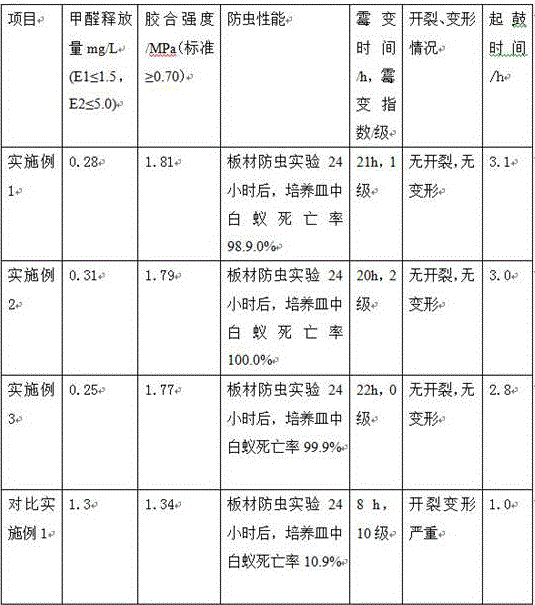Method for producing cabinet board with anti-insect and anti-mold composite urea-formaldehyde resin
A technology of urea-formaldehyde resin and urea-formaldehyde resin glue, which is applied in the field of producing cabinet boards with insect-proof and mildew-proof composite urea-formaldehyde resin. Good film-forming effect
- Summary
- Abstract
- Description
- Claims
- Application Information
AI Technical Summary
Problems solved by technology
Method used
Image
Examples
Embodiment 1
[0067] A method for producing cabinet boards by using an insect-proof and mildew-proof composite urea-formaldehyde resin. The cabinet boards have the following structure from top to bottom: decorative paper, fir veneer, particle board, and back board; the cabinet boards are surrounded by aluminum alloys; fir veneer Insect-proof and mildew-proof compound urea-formaldehyde resin adhesive is applied between the particleboard and the backboard, and insect-proof and mildew-proof compound urea-formaldehyde resin adhesive is applied between the particleboard and the backboard. The specific steps include: the preparation of the particle board, the fir veneer and the back board are respectively glued and pasted to cover the particle board, and the decoration process.
[0068] The preparation process of described particle board is:
[0069] 1) After simple screening, the waste materials that cannot be used in the process of making multi-layer eucalyptus boards after rotary cutting eucal...
Embodiment 2
[0095] A method for producing cabinet boards by using an insect-proof and mildew-proof composite urea-formaldehyde resin. The cabinet boards have the following structure from top to bottom: decorative paper, fir veneer, particle board, and back board; the cabinet boards are surrounded by aluminum alloys; fir veneer Insect-proof and mildew-proof compound urea-formaldehyde resin adhesive is applied between the particleboard and the backboard, and insect-proof and mildew-proof compound urea-formaldehyde resin adhesive is applied between the particleboard and the backboard. The specific steps include: the preparation of the particle board, the fir veneer and the back board are respectively glued and pasted to cover the particle board, and the decoration process.
[0096] The preparation process of described particle board is:
[0097] 1) After simple screening, the waste materials that cannot be used in the process of making multi-layer eucalyptus boards after rotary cutting eucal...
Embodiment 3
[0123] A method for producing cabinet boards by using an insect-proof and mildew-proof composite urea-formaldehyde resin. The cabinet boards have the following structure from top to bottom: decorative paper, fir veneer, particle board, and back board; the cabinet boards are surrounded by aluminum alloys; fir veneer Insect-proof and mildew-proof compound urea-formaldehyde resin adhesive is applied between the particleboard and the backboard, and insect-proof and mildew-proof compound urea-formaldehyde resin adhesive is applied between the particleboard and the backboard. The specific steps include: the preparation of the particle board, the fir veneer and the back board are respectively glued and pasted to cover the particle board, and the decoration process.
[0124] The preparation process of described particle board is:
[0125] 1) After simple screening, the waste materials that cannot be used in the process of making multi-layer eucalyptus boards after rotary cutting eucal...
PUM
 Login to View More
Login to View More Abstract
Description
Claims
Application Information
 Login to View More
Login to View More - R&D
- Intellectual Property
- Life Sciences
- Materials
- Tech Scout
- Unparalleled Data Quality
- Higher Quality Content
- 60% Fewer Hallucinations
Browse by: Latest US Patents, China's latest patents, Technical Efficacy Thesaurus, Application Domain, Technology Topic, Popular Technical Reports.
© 2025 PatSnap. All rights reserved.Legal|Privacy policy|Modern Slavery Act Transparency Statement|Sitemap|About US| Contact US: help@patsnap.com

